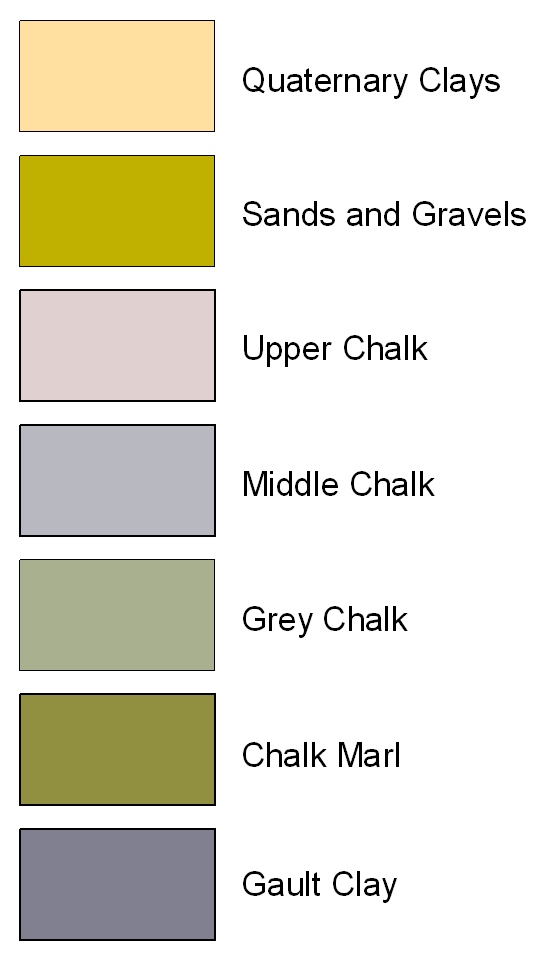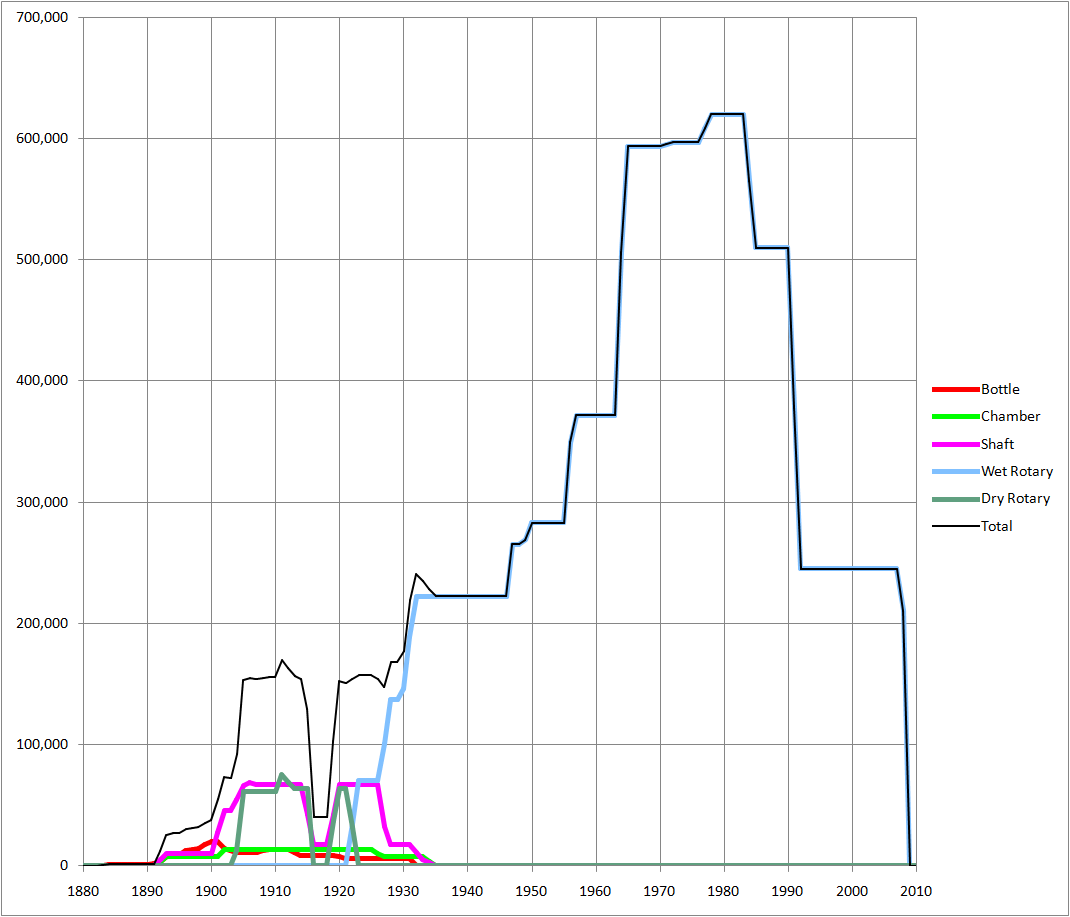

The plant names on this map are clickable, unless your device re-sizes the map.
The Chalk escarpment extends northward from the Thames Valley in the form of the Chiltern Hills. See also an in-depth article on The Chilterns. At its northern end, in East Anglia, the ridge becomes progressively lower and flatter, so that the outcrops of the Lower Chalk and Chalk Marl at the base become much broader. The Totternhoe Stone, which separates these rocks, was historically quarried in Cambridgeshire for hydraulic lime and as “clunch” building stone, while the lower portions of the Chalk Marl were extensively quarried in the mid-nineteenth century for the phosphatic nodules known (erroneously) as “coprolites”, which were used as fertilizer. Most of the marl, except at the base, contains 70-80% calcium carbonate, and when Portland cement began to be popular, many attempts were made to use the marl for cement, the earliest of which was probably Standard. Some sections of the marl were claimed to have about the right chemistry for the Portland cement of the time, and at many locations the marl was burned “as dug” as a “natural” cement. Several plants claimed to possess the only such “perfect” raw material. A number of Portland cement plants started up in this way in the 1880s and 1890s: in most cases it quickly transpired that this method of manufacture would not yield a competitive product.
Butler said of Cambridgeshire cement of the early 1880s: “it certainly was the most utter rubbish that was ever honoured with the name of Portland Cement”!
All the Cambridgeshire plants except the last two (Norman and Barrington) had their origins in the coprolite industry, which enjoyed a substantial boom in the period 1850-1880, and this relationship had a serious negative effect upon its early development.
In the Chilterns, the Chalk Marl lies conformably on the Gault Clay below, the transition often being barely perceptible. The bottom part of the Marl is called the Glauconitic Marl, containing green glauconite and having an increased phosphate content. From Norfolk northward, the lower Cretaceous progressively disappears. The transition between these states begins in the district between Arlesey and Soham, where the contact between the Marl and Gault becomes unconformable, and the base of the Marl lies on an erosion surface at the top of the Gault. The Glauconitic Marl is here called the Cambridge Greensand. This is typically only about a metre thick, and differs in that it contains phosphatic nodules. Because of their characteristic shapes, these were termed "coprolites" in the area, although they are actually concretions. The special circumstances of the area led to erosion of fossiline materials from the nearby Lower Cretaceous and Jurassic rocks, and these accumulated on the erosion surface. The calcite of the fossils was then replaced with apatite by the phosphate-rich waters.
The realisation that these nodules could contain 50-80% apatite led to their exploitation for fertiliser from the late 1840s onward. Initially the small Cambridge Greensand outcrop was dug. The nodules were liberated from their marl matrix by use of a washmill, originally horse-driven, but later steam-driven. The next stage of exploitation was to dig through the Marl to expose the Greensand at the base, and this became the major mode of extraction from the 1860s. The technique was everywhere the same: a long trench, typically with a tram track at the bottom, was dug through the marl, and the trench was then dug laterally - as a "slot-mine", transferring the marl across the trench to the worked out side, and finally transferring the topsoil. In this way, whole Cambridgeshire open fields had their underlying Greensand removed, and were restored to agriculture, lowered by a metre or so. The practical limit to the depth of hand-dug slots of this sort was 6 metres, so that areas with the bottom 6 m of the Marl outcrop could be worked.
The extraction of "coprolite" was highly labour-intensive, and at its height, several thousand men were employed. The economics of the industry were such that, at the beginning, the nodules were a cheaper phosphate source than the previously-used imported guano. However, from around 1880, imports of phosphate rock from the USA and Morocco began, and immediately undercut the local industry, which rapidly collapsed, causing serious unemployment in an area already affected by agricultural depression. It was as an alternative use of the available cheap labour that the Gault brick and cement industries were developed. A curious aspect of this innovation in the 1880s was the influence of the long-serving Cambridgeshire County Analyst, James West Knights. A major part of his earlier work was the assaying of the local phosphate production. He now found a new commercial outlet for his services, by analysing marl and pronouncing it to be "a natural mixture of chalk and clay in the proportion requisite for the manufacture of the finest Portland Cement". All the Cambridgeshire plants used him for this, and he acquired directorships in several of them. The new mode of running the "coprolite" mines was, instead of reinstating the land (at some expense), the overlying marl was crushed and burned without any further processing.
There was a snag in this apparently lucrative business model. Almost everywhere where it occurs, the Chalk Marl trends in calcium carbonate content, with high at the top and low at the bottom. In the Cambridge area, the Chalk Marl is about 40 m thick, and contains about 78% CaCO3 at the top, and 70% at the bottom, with a fairly linear variation in between. The "coprolite" mines necessarily yielded only the bottom few metres of the bed. Cement plants using this yielded a cement that not only was weak, variable and unreliable, but also did not class as Portland cement at all. Some plants continued (or attempted to continue) making cement of this sort throughout their brief and intermittent lives - plants such as Standard, Meldreth, Bottisham Lode and Romsey Town gave the Cambridge product its infamous reputation.
The plants that survived longer began making a blended rawmix using marl with or without added Grey or Middle Chalk. Most of the plants remained small, the last plant created (Barrington in 1927) being the largest. Only two plants (Norman and Barrington) invested in rotary kilns, but the simplicity of manufacture in the area allowed a few plants with static kilns to struggle on until the last three (Cam Blue Lias, Rhee Valley and East Anglian) were killed off by the Depression years 1926-1934. This left only the rotary plants, and the closure of Norman in 1984 and Barrington in November 2008 marked the extinction of the area’s cement industry.
